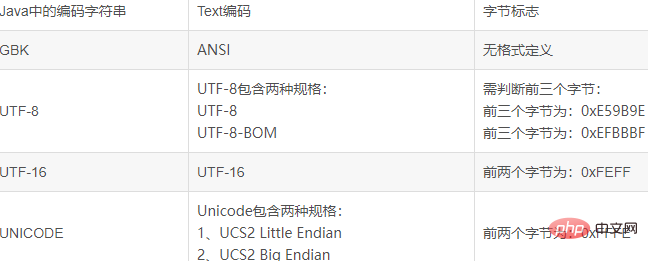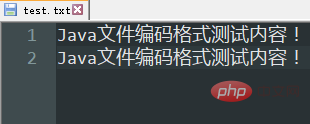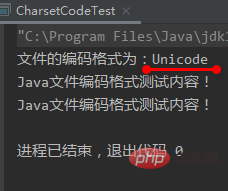Java implements obtaining the character encoding of a text file

1. Understanding character encoding:
1. The default encoding of String in Java is UTF-8, which can be obtained using the following statement: Charset.defaultCharset( );
2. Under the Windows operating system, the default encoding of text files is ANSI, which is GBK for Chinese Windows. For example, if we use the Notepad program to create a new text document, its default character encoding is ANSI.
3. Text text documents have four encoding options: ANSI, Unicode (including Unicode Big Endian and Unicode Little Endian), UTF-8, UTF-16
4, so we read txt files may sometimes not know their encoding format, so a program needs to be used to dynamically determine the encoding of the txt file.
ANSI : No format definition, for Chinese operating systems it is GBK or GB2312
UTF-8 : The first three bytes are: 0xE59B9E (UTF-8), 0xEFBBBF (UTF-8 inclusive BOM)
UTF-16: The first two bytes are: 0xFEFF
Unicode: The first two bytes are: 0xFFFE
For example: Unicode documents start with 0xFFFE, use The program just takes out the first few bytes and makes a judgment.
5. Correspondence between Java encoding and Text encoding:

Java reads Text files. If the encoding format does not match, garbled characters will appear. Therefore, you need to set the correct character encoding when reading text files. The encoding format of Text documents is written in the file header. In the program, the encoding format of the file needs to be parsed first. After obtaining the encoding format, reading the file in this format will avoid garbled characters.
Free online video tutorial recommendation: java learning
2. For example:
There is a text file: test.txt

Test code:
/**
* 文件名:CharsetCodeTest.java
* 功能描述:文件字符编码测试
*/
import java.io.*;
public class CharsetCodeTest {
public static void main(String[] args) throws Exception {
String filePath = "test.txt";
String content = readTxt(filePath);
System.out.println(content);
}
public static String readTxt(String path) {
StringBuilder content = new StringBuilder("");
try {
String fileCharsetName = getFileCharsetName(path);
System.out.println("文件的编码格式为:"+fileCharsetName);
InputStream is = new FileInputStream(path);
InputStreamReader isr = new InputStreamReader(is, fileCharsetName);
BufferedReader br = new BufferedReader(isr);
String str = "";
boolean isFirst = true;
while (null != (str = br.readLine())) {
if (!isFirst)
content.append(System.lineSeparator());
//System.getProperty("line.separator");
else
isFirst = false;
content.append(str);
}
br.close();
} catch (Exception e) {
e.printStackTrace();
System.err.println("读取文件:" + path + "失败!");
}
return content.toString();
}
public static String getFileCharsetName(String fileName) throws IOException {
InputStream inputStream = new FileInputStream(fileName);
byte[] head = new byte[3];
inputStream.read(head);
String charsetName = "GBK";//或GB2312,即ANSI
if (head[0] == -1 && head[1] == -2 ) //0xFFFE
charsetName = "UTF-16";
else if (head[0] == -2 && head[1] == -1 ) //0xFEFF
charsetName = "Unicode";//包含两种编码格式:UCS2-Big-Endian和UCS2-Little-Endian
else if(head[0]==-27 && head[1]==-101 && head[2] ==-98)
charsetName = "UTF-8"; //UTF-8(不含BOM)
else if(head[0]==-17 && head[1]==-69 && head[2] ==-65)
charsetName = "UTF-8"; //UTF-8-BOM
inputStream.close();
//System.out.println(code);
return charsetName;
}
} Running results:

Recommended related articles and tutorials: Getting started with java
The above is the detailed content of Java implements obtaining the character encoding of a text file. For more information, please follow other related articles on the PHP Chinese website!

Hot AI Tools

Undresser.AI Undress
AI-powered app for creating realistic nude photos

AI Clothes Remover
Online AI tool for removing clothes from photos.

Undress AI Tool
Undress images for free

Clothoff.io
AI clothes remover

AI Hentai Generator
Generate AI Hentai for free.

Hot Article

Hot Tools

Notepad++7.3.1
Easy-to-use and free code editor

SublimeText3 Chinese version
Chinese version, very easy to use

Zend Studio 13.0.1
Powerful PHP integrated development environment

Dreamweaver CS6
Visual web development tools

SublimeText3 Mac version
God-level code editing software (SublimeText3)

Hot Topics
 1359
1359
 52
52
 Square Root in Java
Aug 30, 2024 pm 04:26 PM
Square Root in Java
Aug 30, 2024 pm 04:26 PM
Guide to Square Root in Java. Here we discuss how Square Root works in Java with example and its code implementation respectively.
 Perfect Number in Java
Aug 30, 2024 pm 04:28 PM
Perfect Number in Java
Aug 30, 2024 pm 04:28 PM
Guide to Perfect Number in Java. Here we discuss the Definition, How to check Perfect number in Java?, examples with code implementation.
 Random Number Generator in Java
Aug 30, 2024 pm 04:27 PM
Random Number Generator in Java
Aug 30, 2024 pm 04:27 PM
Guide to Random Number Generator in Java. Here we discuss Functions in Java with examples and two different Generators with ther examples.
 Armstrong Number in Java
Aug 30, 2024 pm 04:26 PM
Armstrong Number in Java
Aug 30, 2024 pm 04:26 PM
Guide to the Armstrong Number in Java. Here we discuss an introduction to Armstrong's number in java along with some of the code.
 Weka in Java
Aug 30, 2024 pm 04:28 PM
Weka in Java
Aug 30, 2024 pm 04:28 PM
Guide to Weka in Java. Here we discuss the Introduction, how to use weka java, the type of platform, and advantages with examples.
 Smith Number in Java
Aug 30, 2024 pm 04:28 PM
Smith Number in Java
Aug 30, 2024 pm 04:28 PM
Guide to Smith Number in Java. Here we discuss the Definition, How to check smith number in Java? example with code implementation.
 Java Spring Interview Questions
Aug 30, 2024 pm 04:29 PM
Java Spring Interview Questions
Aug 30, 2024 pm 04:29 PM
In this article, we have kept the most asked Java Spring Interview Questions with their detailed answers. So that you can crack the interview.
 Break or return from Java 8 stream forEach?
Feb 07, 2025 pm 12:09 PM
Break or return from Java 8 stream forEach?
Feb 07, 2025 pm 12:09 PM
Java 8 introduces the Stream API, providing a powerful and expressive way to process data collections. However, a common question when using Stream is: How to break or return from a forEach operation? Traditional loops allow for early interruption or return, but Stream's forEach method does not directly support this method. This article will explain the reasons and explore alternative methods for implementing premature termination in Stream processing systems. Further reading: Java Stream API improvements Understand Stream forEach The forEach method is a terminal operation that performs one operation on each element in the Stream. Its design intention is




